#Mesopotamian Figures
Text
4,000 years ago, Mesopotamian king Iddin-Dagan engaged in a massive public event to bring fertility to the land, culminating in his public copulation with a temple priestess.
#Sumer#Sumerians#Mesopotamian Figures#Mesopotamian Society & Culture#Mesopotamian Gods & Religion#Inanna#priestess#ceremony#fertility#ritual
52 notes
·
View notes
Text

<- the shepherd in question
#he takes on different forms; he can turn into a sheep a bird a gazelle a flower and;;; lettuce#but his original form is that of a beautiful man#he was an ancient mesopotamian deity associated mostly with agriculture and shepherds#and like g.ilgamesh; he also appears on the sumerian king list#curiously enough he's stated to have also been an ancient king of the city of uruk as well like gil!#its a situation that is sort of like how some people believe king arthur existed and ruled somewhere#and others just think he was just a literary figure#I'm going to be honest with u chief i dont really vibe with his style in f.ate so im giving him a diff fc#he's still pretty much the same but i just want him to have pretty long eyelashes and beautiful fluffy hair#;d.umuzid
10 notes
·
View notes
Text
^saw a post with Sumerian art and almost tagged to with some dumb shit because I got so excited
#LISTEN. LISTEN. SUMERIAN AND MESOPOTAMIAN ART MAKES ME GO CRAZY I SEE IT AND MY BRAIN DOES SOMETHING#My art history class last semester did nothing but make me such a fucking loser nerd about ancient art#I will see pointed arches and immediately be like ‘oh that’s gothic architecture!’ and get so happy#<- gothic art isn’t technically ancient but yk#MY BESTIE SHOWED ME A PICTURE THEY TOOK IN AN IRISH CATHEDRAL EARLIER AND I HAD TO STOP THEM TO TRY AND FIGURE OUT WHAT PERIOD THE ART WAS#(99% sure it was Byzantine)#spacey speaks#if I was confident enough in the art history at my school I’m telling you I would get a minor in it. if they offered any classes that were-#deep diving into Sumerian and Mesopotamian art I would take that in a heart beat
5 notes
·
View notes
Text
Mesopotamian Mythological Figures to Use for Dislyte Ocs:
Anu, Enki/Ea, Enlil, Gilgamesh, Marduk, Tiamat, Ishtar/Inanna, Ereshkigal, Nanna/Sin, Enlil, Ningal, Ninhursag, Mamu, Hadad, Nabu, Assur, Simut, Nergal, Ninsianna, Ninurta, Dumuzid, Gula, Nimintabba, Nindara, Ninegal, Ninkarrak, Bau, Ishkur, Itsaran, Nanaya, Nanshe, Ninmug, Ninpumuna, Lulal, Iiaba, Ishmekarab, Irnina, Isimud, Ishum, Kabta, Kanisurra, Ki, Kus, Kusu, Lagamar, Laguda, Mami, Mammitum, Mandanu, Manzat, Martu, Misharu, Nanibgal, Ninsar, Lugaldukuga, Nammu, Lahar, Las, Dumuzi-abzu, Duttur, Emesh, Enbilulu, Ninmena, Shuishaga, Ninkilim, Ningirima, Ningishzida, Ningublaga, Tiamat, Alammus, Ama-arhus, Uttu, Wer, Ningal, Ningikuga, Tutu, Uras, Ningirida, Ninhegal, Ninimma, Erra, Erragal, Ezina, Gareus, Gazbaba, Geshtinanna, Gibil, Gugalanna, Ninazu, Ninlil, Ninshubur, Nisaba, Zababa, Alala, Belili, Anshar, Kishar, Duri, Dari, Enki, Ninki, Tashmetu, Urkitum, Usur-amassu, Enmesharra, Gunura, Gatumdug, Haya, Hegir, Hendursaga, Humhum, idiurugu, Ninigizibara, Lumma, Ninkasi, Ninkurra, Ninmada, Ninmarki, Bitu, Bizilla, Damu, Dingirma, Amasagnudi, Amashilama, Antu, Asarluhi, Ashgi, Aya, Bel-Sarbi, Belet-Seri, Bilgames, Enkimdu, Enlilazi, Ninsianna, Ninsikila, Ninyu, Nirah, Numushda, Nungal, Nunusdug, Nusku, Pabilsag, Paniginarra, Ninisina, Nintinugga, Lisin (brother is ashgi), Lugala'abba, Lugalbanda, Lugal-irra and Meslamta-ea, Sadarnunna, Sarpanit, Sarrahitu, Serua, Shala, Shara, Subula, Shullat and Hanish, Ennugi, Enten, Shulpa'e, Shui-utula, Shuzianna, Sirsir, Siduri, Silili, Sumugan, Tadmustum, Allani, Asratum, Belet-Šuḫnir and Belet-Terraban,
Note: Keep in mind that this list may not be accurate and/or may be missing some mythological figures because I put down what I knew and did the bare minimum of google searching.
#Dislyte#Dislyte oc#Dislyte oc's#Mythological figures for Dislyte oc's#Mesopotamian Gods#Mesopotamian Mythology#Mesopotamian Dieties
18 notes
·
View notes
Text
my naming scheme for the resurrectionists causes me undue stress a lot of the time but when it works it Works
#edgar mortis is obv edgar allen poe + latin word for death. and his surname plays off the fact that there are four other resurrection men#only identified by their surnames which are pallor livor rigor and algor. rigor mortis should be easy to clock but the rest are all stages#of death as well when you attach -mortis to the end of them. which cements edgar's identity as a resurrection man even when he's farrr too#consumed by morana's world of magic and mystery to be actively working.#morana faust is a slavic death goddess + faust. the most famous necromancer in all of fiction. once again her surname cements her identity#as a necromancer specifically even when she gets swept away by unrelated magical happenings#nine and shi aren't their real names but their identification numbers are 9444999 and 4999444. 9 and 4 are both associated with death and#each of their numbers are the other's but reversed. also nine was a classical composer in life and there's a superstition that classical#composers will not live to write their 9th symphony (he sure as hell didn't lol) so it's fitting that he's the one who ended up with the#nickname. abberline isn't his real name either so he doesn't count. valdís has ancient norse for 'death' (val) + 'dis' (goddess) despite th#name not actually being used for any actual death goddess and her surname toth is likely derived from a medieval german word for death#her name isn't glaringly out of place with the rest of the cast but doesn't immediately let you catch on to her whole deal#which is good bc valdís is meant to sort of blend into the backround of reader's minds until The Reveal.#mara is a minor hindu goddess of death and her surname grave is. well. self explanatory. i tried to give the more non-magical side of londo#more straightforward names to contrast with some of the others and obv her dad was created before her and dr grave seemed like a good name#for someone who only popped up in the story while he was hiring professional grave robbers (now he pawns that task off on mara lol)#ereshkigal kore is just queen of the underworld + queen of the underworld but def has a very grandiose feel which is good bc that's#absolutely the vibes she should be giving off. all her servants' names boil down to figures associated with the greek + mesopotamian#underworlds. mainly attendants of aforementioned goddesses. which fits bc they all serve her#but i'd like to give special consideration to the maid trio here bc they're a set of triplets. and their last name is cerberus.#which famously had 3 heads. and the older two feature a similar naming scheme as persephone + eurydice (they even both end in the same e#sound) but the youngest's name is aisha which means 'living' or 'alive'. and obv her departure from the naming scheme makes her more easily#differentiated from her sisters + more memorable in the long run which is good bc she's the most important maid but it also gives me room t#have a 'my name means alive but she's named for the queen of the underworld so i'm willing to not live up to my name if it means being#closer to her' moment w a shitton of lilies in frame in case it isn't clear to anyone what's going on ('her' means eresh not persephone btw#and then there's dysmas. the patron saint of undertakers. which fits bc catholic. and sanson. as in the executioner. for a character heavil#inspired by the nasuverse's church executioners like kirei and ciel#rosette comes from the rosette nebula which looks like a skull. hayden is from one of my kids at work who said that next time i wrote a#murderer into something i had to name them after her so. here you go hayden. you get to be the cannibalistic child. (the topic came up when#i had to make a murder mystery for class so i stole the names from my kids and i told the ones whose names i used abt it later and she was
3 notes
·
View notes
Text
do you ever look at a character's name and you're just like -- where in the absolute fuck did I get this from????
#Ryn rambles#I'm...fairly certain I figured out where I got Sarrat from (Queen Sammu-Ramat)#but what about Kuvav??????#I know it had something to do with a Mesopotamian queen but --#which one???#fuck if I know I didn't have the foresight to write it down somewhere I could remember to check#I'm working on getting all my characters down so I don't forget#and I need a bit of fun after stressing and turning in my essay#barely got it in but. there we go#I promise I'm having a great time with digging through my notes app and Google docs to find info about my OCs
0 notes
Text
The more I learn about John Constantine? The more I am certain you COULD just... dump Danny on him.
Like... literally.
Full on, sack of unconscious potatoes, "here ya go, deal with it, here's an unconscious royal teenager!", Dumped in his arms/lap at some shitty hole in the wall bar, by Suspicious Supernatural Forces, DUMPED on him. Like? Yep. It's a Tuesday. Guess he's NOT getting to finish this beer.
And you know what?
Knowing the crowd Danny runs with? They'd at least... SORTA try and explain what's happening? Instead of play the fun ol "HOT POTATO! Think fast, Constantine! Figure it out!" And run shpeal that he normally deals with. Thoughtful, really.
Don't get him wrong. It's still BULLSHIT. But at least he has a vague idea of WHY he's holding an unconscious, heavily bleeding, half-divine-but-not-really half human, teenager.
Fuckers left a few sticky notes.
THANKS.
He just LOVES patching up actively radioactive wounds while trying to translate... what is this? Mesopotamian? Who writes out their emojis in Mesopotamian?! "Smiling face emotional picture" my ASS. Still...
Kid in way over their head, hunted by damn never everyone for trying to do the right thing, AND grappling with their recent lose of a decent chunk of their own humanity? Oh and now he's KING of a whole spankin new Realm!
Fuck "Realms". Nothing ever good comes out of "Realms".
And APPARENTLY? His VIP returning customers spot under the Bus has been reserved! Because he's the kid's "Gaurdian". Why? So the nice Goverment stooges in suits will come knocking on HIS door first, of course.
......he'd be more pissed about that one if he wasn't REAL interested in what those bastards had to say for themselves. Meddling with forces they shouldn't be touching. Provoking God only knows what. He fucking KNEW those storms weren't natural.
Just? John getting handed a Suspect Youth. Press X for doubt and Sus. Okay... then give him back. No! Fuck you, says local Laughing Magician, I don't trust you EITHER.
Danny wakes up to the... VERY? Ngl? Intense(tm) stare down of... holy shit, are you an Actual Angel? (Yes. He is. Better hope you're not secretly evil or he's gonna bring The Smiting) Then the world's ACTUAL greatest Detective, who is a chimpanzee, offers him expertly made tea and the cheap take-out John brought with him.
He is in Space.
It's still not the weirdest morning he's ever had. But it's getting there.
@the-witchhunter @hdgnj @hypewinter @nerdpoe @lolottes @babbling-babull
2K notes
·
View notes
Text
In my World History zoom lecture today one of my classmates was curious about the origin of wine production and I was taken aback for a moment at the realization that the average person is not elbows deep in the "which came first-- wine, mead, or beer" debate, or in ancient alcohol-making discourse generally.
#not sure if being this entrenched is a blessing or a curse lmao#like you're not constantly thinking about what prehistoric mesopotamian person figured out barley distillation? ok#the ancient world#the college saga continues
1 note
·
View note
Text
One of the things I hear a lot from Gentile witches and neo-pagans who want to work with Lilith or claim to work with Lilith, is that she is actually a Mesopotamian goddess, usually either Ishtar/Inanna or Erishkigal, and that it was the Jews, with their horrible patriarchy juice, who slandered her and cast her down, and so the Jews do not deserve to say what happens to her and it isn't antisemitism to work with her, or to completely ignore what the Jews say about what she is in a Jewish context.
Lilith is not Ishtar or Erishkigal. However, there is a Mesopotamian figure that is pretty stinking analogous to Lilith, and is probably her folkloric ancestor, by which I mean the idea of Lilith probably comes from this Mesopotamian figure. In fact, Lilith almost certainly is either a Jewish version of this figure, or, they are both descended from the same Near Eastern and Mediterranean basin folkloric figure. That figure is Lamashtu.
Lamashtu is, much like Lilith, the supernatural embodiment of maternal and infant mortality, a figure of power and terror, who functions as a way to embody and cope with the profound dangers that are pregnancy, childbirth, and infancy without effective medical care. the Mesopotamians never worshiped Lamashtu, but they did seek to appease her, including making symbolic gifts to her, to keep her from visiting them, and killing them or their children.
An interesting side note is that there is also a Mesopotamian figure who specifically opposes Lamashtu and functions as the protector of pregnant women and infants, and that figure is Pazuzu, a wind spirit, who ruled over other wind spirits, including ones called the Iilu in the Akkadian language. Akkadian is a Semitic language, related to Hebrew, and this word is probably a cognate of Lilith, but the Iilu probably have no relationship to the figure of Lilith except her name. You might know Pazuzu as the demon featured in the movie, The Exorcist, and ironic fate for a mythological protector of women and children.
Anyway, if you'll remember, I implied above that the Lamashtu/Lilith figure, was present in various guises throughout the Mediterranean basin and the Near East, so there are of course figures analogous to both of them throughout the region, such as Lamia of Greece, and the Strix of Rome.
So if you really really want to work with a figure who functions as the supernatural embodiment of maternal and infant mortality, Lamashtu, Lamia, or the strix would all be excellent options that don't come from an extant closed religious practice. All the baby killing, none of the antisemitism and cultural appropriation.
While all three figures are almost certainly descended from the same folkloric root, they're all subtly different, because as stories and characters travel, they change. as such, they all have particular good points about them as figures of veneration.
Lanashtu is the OG bad bitch, who commanded fear, respect, and offerings, like a mythological mafiosa, collecting protection money.
Lamia has attached to her the story that she was one of Zeus's dubiously willing lovers, who was screwed over first by Zeus, the embodiment of patriarchical rule, then by a jealous Hera, the embodiment of patriarchal marriage, so if what attracted you to Lilith was the story from the Alphabet of Ben Sira, about a victim of the patriarchy getting her own back through violent vengeance, Lamia might be the girl for you. With her however, the emphasis is less on her murder of children, then on her seducing and eating men, though she does also get strongly associated with killing children, especially boys.
And the strix is particularly interesting, because the word comes down to us in the modern Italian word for witch, striga. Indeed, one of the theories as to where the witch figure came from in Early Medieval, and then Early Modern Christianity, was as the strix demon made human. This might explain the close association between Early Modern Witchcraft and infant mortality, including Italian stories of witches causing infants to die seemingly natural deaths, so that they could dig them up and eat them after their funerals, something that ties these human supposed witches very closely to demonic folkloric antecedents. If you are looking for a figure of unfairly maligned female power, the strix and her close association with later human witches, might be the one for you.
All three of these figures, much like Lilith herself, are reflections, both of the power women wielded even within patriarchal societies, over the process of pregnancy, birth, and childrearing, and also the powers of death and loss that everyone was subject to. There is something powerful, transgressive, and even healthy in acknowledging the fears and dangers presented by this death and loss,and for some people, that might take the form in venerating the underlying powers. If this is something that would be spiritually meaning for you, and you wish to work with such a figure, and you are not Jewish, please respect the fact that Lilith is part of a closed religious practice, and remember that Lilith has sisters, in other parts of the Mediterranean basin and the Near East, who are not from extant closed cultures, and who might serve your needs better anyway.
667 notes
·
View notes
Text
Day five of fic NaNoWriMo; obligatory sugar daddy Tim/sugar baby Kon AU.
The Superboy problem is a problem, but it's a backburner problem. There isn't really much Tim can do about it, after all. Bruce isn't gonna accept "hey so I know secret identities and maintaining the Bat-mystique and everything but could you just like . . . take in an extremely high-profile teenage superhero with no vested interest in maintaining any kind of secret identity of his own, maybe?" as a plan. Tim needs something better. Something more functional. And also something Kon will actually go for.
And there's just no way that Tim can just walk up to a notoriously independent and proud and defensive teammate who barely considers him an acquaintance and say "do you want an apartment and monthly living expenses and maybe also an allowance, no strings attached?"
That would be weird, definitely.
Like. Very definitely.
Tim's still tempted to try it, mind. It's not like he couldn't afford it, with a little bit of abuse of his trust fund and a lot of lying to his dad. And really, would that even be an abuse? If helping his teammate live his fucking life outside of a fucking lab counts as an abuse . . .
Well, maybe he really will move up his supervillain timeline, that's all.
But it's a backburner problem, still, and Tim isn't actually thinking about it at all when his best chance to solve it pops up. What Tim is doing is suffering through a field trip to a Metropolis art museum, because the school board is full of cowards and thinks sending his grade to an outside-Gotham museum will decrease the chances of said field trip being interrupted by a museum robbery.
Obviously it will, but come on, they're from Gotham. Like they can't handle a museum robbery.
Also all the art here is pretentious. Like, in obnoxious Metropolis-type ways.
If Tim has to look at one more stylized interpretation of the sun reflecting on a skyscraper while a "subtle" caped figure flies by in the background, he will actually choke. Like literally, actually choke.
Get one original thought. Please. Someone. Anyone.
(No, the stylized interpretations of the moon reflecting on a Gothic building while a subtle caped figure looms among the gargoyles are not equally uncreative, thank you very much. At least duplicating Gotham architecture involves some actual artistry beyond "paint a few straight lines and add a lens flare".)
Tim takes some half-assed notes about the boringly generic exhibit they're here to see and then goes looking for literally anything more interesting than said exhibit. There's got to be some photography somewhere in this place, right? Or at least some loaner art that somebody outside of Metropolis put together before Superman's public debut. Or something.
He ends up in the ancient Mesopotamian exhibit mostly by trying to avoid people and, unfortunately, immediately runs straight into a magical artifact. He doesn't actually know it's magic at the time, but the assholes who are about to blow in an outside wall in pursuit of it sure do.
Tim, unfortunately oblivious to phenomenal cosmic power in clay form, thinks it looks kind of like a cute little toy goat and is just grateful it isn't another skyscraper.
Then the wall gets blown in.
"The school board deserves this," Tim mutters, closing his notebook and sticking it back in his bag because sure, why not. This might as well happen.
Ugh.
The very obvious thieves rush in through the gap in the wall. A few people scream–Tim assumes to be polite, since this is already the most unimpressive museum robbery he's seen in months–and the civilians scatter as the guards rush forward. Tim wonders why anyone's even bothering, given that this is Metropolis. What, are they worried the thieves aren't gonna validate their parking for them?
Seriously, Tim knows all the robbery statistics in this city. Even when Superman doesn't show up, the injury and fatality rates are shockingly low. It's statistically more dangerous to go for a walk in Gotham Park mid-afternoon than it is to be present for an armed robbery in Metropolis.
Which is funny, considering the people doing armed robberies in Metropolis come armed for Superman.
Look, Tim doesn't understand the statistics, he just records them.
The thieves tie up the guards first, which seems like a waste of time to Tim when time is of the essence but probably will be for the best if they get pinned down in the gallery, he supposes. Then again, that'd likely end up in a hostage situation anyway, so why worry about containing a couple of unarmed guards over saving thirty seconds when you're doing a smash and grab?
Seems inefficient to him, considering.
He keeps assessing the situation and taking mental notes as he ushers various classmates and museum-goers towards comparative safety, since a successful supervillain timeline requires appropriate research and development. And also, Metropolis-based criminals should know how to work around Superman, at least in theory, so it's best to keep an eye on what does and doesn't work for them.
Not for any specific reason, obviously.
Definitely not.
One of the thieves goes for the little clay goat, smashing its glass display case with their armored elbow, and only then do the museum alarms start screaming. Seems like a stupid design choice when an exploding wall doesn't set them off, but whatever, at least there are alarms.
Honestly, if it were him, Tim would have a silent alarm and a secondary alarm set to a specifically Superman-discernable frequency, though he's sure Superman would get sick of that quick in non-life-threatening situations, so maybe there are local regulations about that or something, who knows. He should look into that, actually. Or just play something annoying on a frequency normal human hearing can’t discern and see what happens, if nothing else.
They make sonic fences to keep dogs in and teenagers out, don't they? Same theory.
The thieves are all yelling orders to each other and arguing; no clear chain of command and a poorly-established plan, Tim notes. Most of the civilians are clear or behind cover, so if he just–
Right, Tim remembers belatedly as one of the thieves makes a grab for him. He's currently wearing civilian wear, isn't he.
That probably means he needs to let this incredibly clumsy grab work, doesn't it, he reflects resignedly. Definitely it does, actually.
Ugh.
Tim, dubiously, lets the thief grab him and debates how upset he's supposed to look about this situation. A Gothamite can't look too freaked out over a Metropolis criminal, obviously; he'd never live it down at school. Seriously, is this guy even armed, he–
Ah, never mind. Definitely armed.
And an idiot with no concept of trigger safety, judging by the way he's holding the gun he's currently jamming into Tim's temple.
Great. Just great.
What does this moron even think he's doing, anyway? The guards are all tied up, as far as he knows there's no superheroes on scene, and nobody's actually trying to stop them. If he accidentally murders a civilian right now, they're all going to be in way, way worse trouble than just stealing a little clay goat would entail.
Tim resists the urge to point that out since there is, again, a gun to his head right now and the person holding it there is in fact a moron with no concept of trigger safety. Not an ideal time to start a conversation, especially not to criticize said moron.
It's tempting, just again, not ideal.
"The fuck are you doing?!" one of the thieves yells to the one going to a really unnecessary amount of effort to drag Tim along. "You were supposed to grab a little kid for the hostage!"
"There's no little kids, Mark!" the thief holding Tim protests petulantly. "I'm doing my best here, man!"
"No names, asshole!" the apparent "Mark" yells back at him.
Tim is pretty sure these thieves are just not very good at crime in general. Or possibly just not very good at anything at all.
He starts calculating the best place to "trip" out of this guy's arms and "accidentally" elbow him in the dick–off-camera, obviously, he doesn't want to leave any footage for anyone to review later–and pretends to be a good little hostage in the meantime, if not a particularly cowed one. Again: Gothamite. He can't actually let it look like a Metropolis criminal did anything worse than mildly annoy him.
Okay, maybe like, Lex Luthor or Brainiac could get a Gothamite past "mildly annoyed", but not a half-assed handful of petty thieves with a shitty plan and an even shittier exit strategy. They would've been better off running in, grabbing what they wanted, and then just scattering; even Superman can't be everywhere at once, especially if the thieves all blended into the crowd or had a couple of getaway cars waiting or something similar. Multiple targets, it'd be easy for him to miss the right one until it was too late.
That would require actual skill and planning and genuine forethought, though, which are very clearly not things this crew has bothered with either developing in themselves or outsourcing to someone competent.
Tim is going to be so fucking embarrassed if he dies to a low-level Metropolis criminal's craptastic trigger discipline. At least the Joker got Jason. There was a plan and actual malicious intent there, and also intentional targeting of specifically him. Tim has apparently just been tagged as "person who looks easiest to hold hostage", which he guesses he could take as a good sign for his acting abilities but honestly is more likely just this guy being a fucking dumbass with less brains than a mummified limpet.
God, imagine what his classmates would put in the yearbook if he died on a Metropolis field trip, too. Actually, no, never mind, he doesn't even want to think about it. Too fucking mortifying a possibility.
The thief drags Tim closer to suitable "tripping" territory, Tim debates how hard he can elbow him and still claim it was accidental, and somebody says, "Are you fucking serious, man?"
Somebody, specifically, is Kon. He's standing in the middle of the hole in the wall in the full leather jacket and S-shield combo, hands on his hips and expression exasperated. Tim has a weird, irrational moment of thinking he actually recognizes him and wants to know how he fucked up this bad, but Kon's eyeing the thieves, not him.
"You know I'm gonna get blamed for this, right," Kon says, gesturing meaningfully at the smashed-in wall. "I always get blamed for the property damage."
"Back off or I'll shoot!" the thief holding Tim yells, jamming the barrel of his gun annoyingly hard into his temple.
"Does 'faster than a speeding bullet' mean nothing to you people?" Kon asks, tilting his head just enough to make it obvious that he's rolling his eyes exaggeratedly.
"Superman is faster than a speeding bullet," another thief snaps. "Not you, you shitty little poser."
"I mean, you could try testing me and then get attempted murder on your crime bingo cards for absolutely zero reason," Kon suggests conversationally, smirking in amusement. "Security cameras still running in here?"
Tim guesses he's saved, technically, but this definitely means he can never tell Young Justice his secret identity, because if Kon recognizes him he will never, ever let him live this down.
Also, everybody at school is going to give him so much shit for getting saved by a Super.
#timkon#tim drake#kon el#conner kent#dc robin#superboy#young justice#young just us#rinfic#long post#wip: obligatory sugar baby kon
345 notes
·
View notes
Text

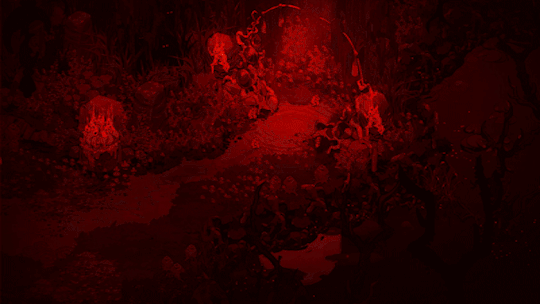

Curse of the Nitghborne.
Guys, I haven't had time to play a lot, but I think the god of this land MAY BE the bad guy, but don't listen to me much.
Get up, folk! Flor did another Curse of Strahdanya crossover after Derek mentioned Lethica fused with Strahdanya as one throw joke in a stream!
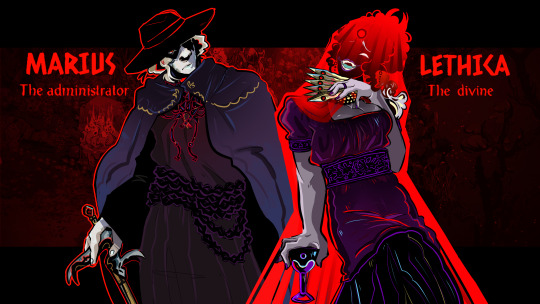


The style is indeed inspired by the great art in Hades (the videogame), and the background is by Hades II.
The drawings without text:
Also, this was written at four in the morning, and I refuse to correct my insomniac ramblings this is the beta experience:

Lethica Nightborne as Strahdanya
----LORE------- In Barovia, a land of the dead, of suffering and grief, a new god has appeared out of nowhere covering the land in an eternal night... Of happiness? Lethica Nightborne, known as the Divine, has presented herself as the saviour that the land needed it, for what seems like decades. Her light, her kindness, her power, has changed the region and the hearts of the people to their core, as the land has been reborn... As there's new blood...
But of course, you can't blame the nature of evil, so there's still death, suffering and pain in Barovia, but of course, our saviour, our dear wife, cleans it as she chooses.
And if she asks for a sacrifice, of course, we will bring it to her, if she asks for the firstborn of every family, we will name the second after her, and if she asks that we take care of her dinner guests, we shall take care of them.
-----DESIGN------- All I knew of Lethica was that I wanted her to wear a veil, and she couldn't only be a countess but a whole god, the saviour of Barovia. The churches don't talk about sun gods, only of her, their lady of dark, their god.
Her dress comes from mixing Stradhanya's and hers, ending in a very 19th figure, with a bit of Mesopotamian fashion (the metal belts and sleeves with the double skirt) to show her as a figure of the past, as somehow older than she appears.
Of course, she had to have some kind of knife so a knife fan, and a cup to show wealth and power (her cup is always full, full of what? Well, if you look at the very pale man under with not a lot of blood left-)
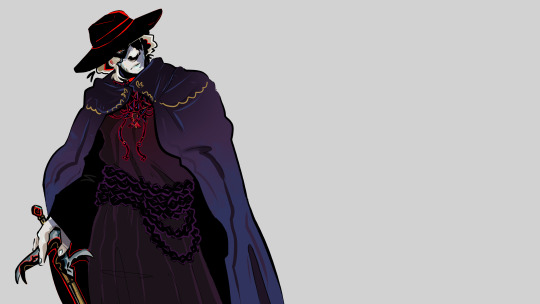
Marius Renathyr as Victoria Issacs
-----LORE------- Marius as a man of Ilmater seems to be QUITE interested in Barovia, a land of suffering and grief, to the extreme that seems too personal to just be a missionary mission to conquer pain.
The university doesn't trust him completely, but somehow, even as a new member of the university and resident of Druskenwald, Marius had found a way to get the vote of everyone involved and the funds for the crusade.
But what would be the real reasons for such travel? Or... WHO is the real reason?
------DESIGN ------ Inspired by the old missionary ropes of the 1800s and the typical vampire hunter, Marius stands as a very weird-looking holy man.
From Victoria's design, we get the rosary turned into this over-complicated necklace and the ropes around his hips that reference the bloody ropes of Ilmater. (Victoria's, and now Marius, god.)
And his sword has turned into a cane. (a cane with a blade.)
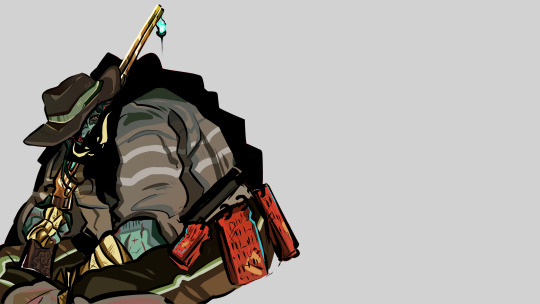
Yorgrim as Silas "Shepherd" Morgan
-----LORE-------- From the depths of Yona, a mercenary is invited to participate in an expedition to a land of death and suffering. He accepts stating that he has other business in Barovia and he could be glad to accompany the group under the condition he would work in peace when need it.
Of course, he refuses to say the kind of work, you know, "professional privacy policy" and all. But by his reputation... It can't be good...
-----DESIGN------- I was going to go with a funeral worker, but the scarf with teeth appeared and it changed the vision.
The design takes more inspiration from Shepherd than Yorgrim, with the hunter theme, with the shotgun filled with blue magic and a list of hunts on red clay (that would be broken when the hit is eliminated.)
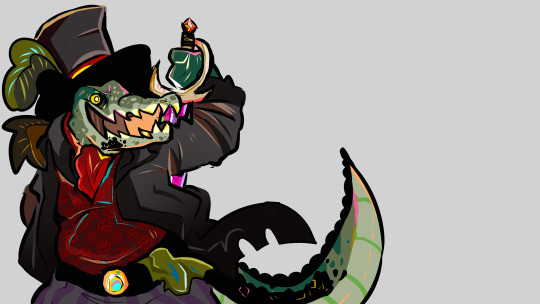
Briggsy "The Kutlass" Kratch as Professor Clayton Azran
LORE------- Briggsy may take the role of the professor, but he's not the expedition's leader. He's contracted by the University of Druskenwald to keep an eye on Marius (since the university is suspicious of the holy man). He accepts, without even wondering or caring what Barovia is, only happy to finally obtain a title under his piracy by the lords of Druskenwald. (He's getting paid to be a pirate, oh the dream!)
DESIGN------ With his design, he was the last one and I was VERY tired, so... It's something weird? You know, a pirate trying to look like a "noble man". (but he's very much failing, he looks like a maniac I think)

Jericho Sticks/Virgil as Sarnax of the Edelwood
----LORE----- The cult of Gherix initially refused the university and the idea of letting them explore the runes in their forest. Until they accept but a month away from the expedition which is extremely suspicious.
When the group found themselves in the forest, there he is, Jericho, a sacrificial figure of sticks and straw offered by the cult as a guide. (Of course, the poor, only brought to life months ago, strawman is a sacrifice in the name of Gherix that, by burning in Barovia, will give the god control over the whole region. / Indeed, Virgil is now Gherix we get an asshole god, give it up!)
-----DESIGN----- Inspired by Wicker Man (giant figures of sticks and straw with animal sacrifices that are burned during Celtic rituals such as the Beltane.) Jericho is turned into a sacrificial figure who will burn when it's necessary by the light that keeps him alive.

Farryn of the Hartsblight as Kana Soyokaze.
-------LORE------- It isn't clear when or how, but Farryn ends up getting involved with the expedition. As a storm in sea, one day, the swordswoman appears out of the blue stating that she's also trying to find her way into Barovia. The deer refuses to explain her business with the "Divine" of all people, only holding her katana with anger and sadness, but she's clearly not looking to make friends. (She ends up being friends with the whole party.)
-------DESIGN----- Based on the Sika deer (a Japanese deer), the design lingers more around the fusion character while keeping Farryn's figure, with the open skirt covered by her leg armour that goes up to her hips and the war paint, fur, and bone that stays in view.
#legends of avantris#edge of midnight#curse of strahdanya#lethica nightborne#marius renathyr#briggsy “the kutlass” kratch#yorgrim#ol' jericho sticks#jericho sticks#virgil (raum)#farryn of the hartsblight#strahdanya#victoria isaacs#professor clayton azaran#silas “shepherd” morgan#sarnax of the edelwood#kana soyokaze#if i had a nickel for everytime that i made a fake videogame for a curse of strahdanya crossover ill have four nickles#which isnt a lot but its weird that it happened like fourth times now#tw long post
224 notes
·
View notes
Text
Hammurabi's Code of Laws, with its emphasis on justice and social order, played a pivotal role in shaping the ancient legal systems of Mesopotamia. It marked a significant step forward in the systematic recording and preservation of laws, leaving an indelible mark in history.
#laws#Hammurabi#Shamash#Mesopotamia#Mesopotamian Figures#Babylon#Kings#ancient#history#ancient origins
31 notes
·
View notes
Text
How To Write Vampires With An Original Twist
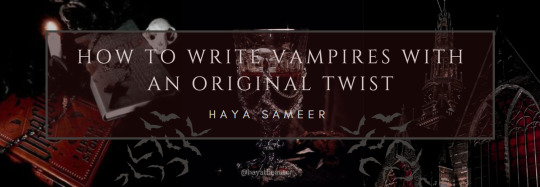
Mythical creatures are an essential part of the fictional scene, but the same creatures have been used so many times that these creatures now often seem redundant and boring in fiction. This is why I've started a new blog series: How To Create Original Mythical Creatures. I'm kicking off this series with vampires!
Join me as we dive into the world of vampires, from their mythical beginnings to their modern-day interpretations, and learn how to write them effectively in your own narratives.
Origins of Vampires
Vampires have a rich and diverse history rooted in ancient folklore and legends. Across various cultures and civilizations, tales of bloodsucking creatures have emerged, each with unique characteristics and behaviors.
One of the earliest known vampire myths comes from ancient Mesopotamia, where stories of blood-drinking demons known as Lilitu or Lamashtu date back to around 3000 BCE. These entities were believed to prey on humans, particularly targeting children and pregnant women.
In ancient Greece, the Lamia was a mythical creature often depicted as a female vampire who lured and devoured children. Similarly, in Roman mythology, the Strix or Strigoi were vampiric entities that fed on blood and flesh.
Moving forward in history, Slavic folklore introduced the concept of the Upyr, a vampire-like creature that rose from the dead to feed on the living. These early depictions of vampires often portrayed them as revenants or undead beings with a thirst for human blood.
Modern-Day Vampires: Where Were They Originated?
The modern concept of vampires, as we commonly know them today, took shape during the European Middle Ages and the Renaissance. Legends of vampires emerged in Eastern Europe, with notable figures like Vlad the Impaler contributing to the folklore. Vlad's reputation for cruelty and his association with impaling enemies on stakes led to the creation of the vampire archetype, inspiring Bram Stoker's iconic character, Count Dracula.
From ancient Mesopotamia to medieval Europe, vampire lore has evolved and adapted, weaving its way into popular culture and literature. Understanding the origins of vampires provides writers with a rich tapestry of mythology to draw upon when crafting their own bloodsucking creatures.
I wanted to go into more detail regarding the Lamashtu and Lamia since they’re not as well known as their Slavic and European counterparts, but unfortunately, that would deviate from the purpose of this blog.
The Evolution Of Vampiric Appearances
Before we proceed with this section, it's crucial to clarify that the mythical creatures and beings discussed in this blog are not direct representations of ancient vampires. Instead, they serve as inspirations for the concept of vampires and share certain attributes with our modern-day depictions, including blood-feeding, pale skin, human-like appearance with some animalistic features, and so on.
Vampiric Creatures In Mythology
In ancient mythology, vampiric entities were not always depicted as the suave, charming figures we see in modern vampire tales. Instead, they often embodied primal fears and monstrous traits.
Lamia: In Greek mythology, Lamia was a terrifying creature depicted as a woman with a serpentine lower body. She was known for her insatiable hunger for children, often depicted as a child-eating monster. Lamia's appearance combined elements of human and serpent, emphasizing her monstrous nature and predatory instincts.
Lamashtu: In Mesopotamian mythology, Lamashtu was a malevolent demon who preyed on pregnant women and newborns. She was depicted with a fearsome appearance, often described as having the head of a lion, the body of a donkey, and bird-like talons. Lamashtu's grotesque features and destructive tendencies reflected ancient beliefs about the dangers of childbirth and infancy.
Lilitu: In Mesopotamian and Jewish folklore, Lilitu or Lilith was often associated with nocturnal demons or spirits. She was depicted as a seductive, winged demoness who preyed on men and newborns. Lilitu's appearance varied across different myths but often included features like wings, long hair, and sometimes talons, emphasizing her otherworldly and dangerous nature.
Strix: In Roman and Greek mythology, the Strix was a bird-like creature or vampiric owl associated with dark omens and death. It was believed to be a shape-shifting creature that could transform into a woman or an owl. The Strix's appearance combined avian and human features, instilling fear and dread in those who encountered it.
Strigoi and Upyr: In Eastern European folklore, Strigoi and Upyr were blood-sucking undead creatures similar to modern-day vampires. Strigoi were believed to be restless spirits or revenants that returned from the dead to torment the living. Upyr, on the other hand, were vampire-like beings with sharp fangs and a penchant for drinking blood. Both creatures were depicted as pale, gaunt, and often with elongated canines, reflecting their predatory and undead nature.
Medieval Depictions: Shift in Appearance
During medieval times, the depiction of blood-sucking mythological creatures underwent a transformation, shifting from monstrous and terrifying to more humanoid and relatable appearances. This change in portrayal can be seen in various aspects of their physical features:
Teeth: Originally depicted with long, sharp fangs or talons for blood-drinking, medieval depictions often featured more subtle fang-like teeth or no visible teeth at all, aligning with the concept of vampires being able to blend in with humans.
Skin: While ancient vampires were often described as monstrous and otherworldly, medieval vampires were portrayed with paler skin to signify their undead nature but without extreme deformities or monstrous features.
Appearance: Medieval vampires were often depicted as more human-like in appearance, with regular clothing and a less monstrous demeanour. This shift allowed for more nuanced storytelling and exploration of themes like temptation, desire, and the struggle between humanity and monstrosity. This is also what birthed the romanticization of vampires.
Mythological Vampire vs Modern-Day Vampire
Mythological vampires, rooted in ancient folklore and mythology, were often depicted as malevolent spirits or creatures with supernatural powers. These creatures varied widely across different cultures, from the Lamia and Lilitu in Mesopotamian mythology to the Strix in Roman and Greek folklore, and the Upyr in Slavic tales.
These ancient vampires were not always the suave, charismatic beings we see in modern media. Instead, they were often portrayed as terrifying and monstrous, with features that reflected their otherworldly nature. For example, the Lamia was described as a demonic woman with the ability to transform into a serpent, while the Lilitu were associated with storm demons and fertility spirits.
In contrast, modern-day vampires, especially those popularized in literature and film, have undergone significant transformation. They are often depicted as sophisticated and alluring, with a penchant for romance and drama. Authors and filmmakers have humanized vampires, giving them complex personalities, tragic backstories, and even moral dilemmas.
While modern vampires still retain some traditional attributes such as a need for blood and sensitivity to sunlight, their portrayal has evolved to include a wide range of characteristics and abilities. This shift has allowed for more diverse and nuanced storytelling, exploring themes of immortality, love, redemption, and the eternal struggle between good and evil.
Which Option Is Better For Your Novel?
When deciding which type of vampire to incorporate into your story, consider the tone and themes you wish to explore. Mythological vampires offer a darker and more primal essence, rooted in ancient fears and superstitions. On the other hand, modern-day vampires provide a canvas for exploring human emotions, relationships, and societal issues through a supernatural lens.
Ultimately, the choice between mythological and modern vampires depends on the narrative direction and atmosphere you want to create. Both types offer unique storytelling opportunities, allowing you to craft captivating tales of mystery, romance, horror, or even philosophical introspection.
Research and Resources
Writing about mythical creatures like vampires requires a solid understanding of folklore, mythology, and literary traditions. Here are some resources and research methods to help you delve into the world of vampires and other mythical beings:
Books and Literature
Start by exploring classic works of literature that feature vampires, such as Bram Stoker's "Dracula," Anne Rice's "The Vampire Chronicles," and Stephenie Meyer's "Twilight" series. These novels not only showcase different interpretations of vampires but also delve into the cultural and historical contexts surrounding these creatures.
Mythology and Folklore
Dive into ancient myths and folklore from various cultures to uncover the origins of vampire legends. Look into Mesopotamian, Greek, Roman, Slavic, and other mythologies to discover different vampire-like entities and their characteristics.
Research Journals and Articles
Academic journals and articles can provide valuable insights into the evolution of vampire folklore, the psychological aspects of vampirism, and the cultural impact of vampire mythology. Explore journals in folklore studies, literary analysis, and cultural anthropology for in-depth information.
Online Resources
Utilize online platforms such as mythology databases, folklore websites, and literary forums to gather information and engage in discussions about vampires. Websites like The Vampire Library, Vampire Empire, and Vampire Rave offer a wealth of resources for vampire enthusiasts and writers.
Historical Research
Delve into historical records, archival documents, and historical accounts related to vampire hysteria, vampire burials, and vampire folklore in different regions. Understanding the historical context can add authenticity to your portrayal of vampires.
Interviews and Expert Opinions
Consider reaching out to folklore experts, historians, and scholars specializing in vampire mythology for interviews or consultations. Their insights and expertise can provide valuable perspectives on vampire lore and storytelling.
Creative Exploration
Don't hesitate to let your imagination roam while exploring vampire mythology. Experiment with creating your own vampire mythology, incorporating unique traits, powers, and origin stories for your vampires.
By combining thorough research with creative exploration, you can develop rich and compelling portrayals of vampires in your writing. Remember to stay open to diverse interpretations and adaptations of vampire folklore, allowing room for innovation and originality in your storytelling.
I hope this blog on How To Write Vampires With An Original Twist will help you in your writing journey. Be sure to comment any tips of your own to help your fellow authors prosper, and follow my blog for new blog updates every Monday and Thursday.
Looking For More Writing Tips And Tricks?
Are you an author looking for writing tips and tricks to better your manuscript? Or do you want to learn about how to get a literary agent, get published and properly market your book? Consider checking out the rest of Haya’s book blog where I post writing and publishing tips for authors every Monday and Thursday! And don’t forget to head over to my TikTok and Instagram profiles @hayatheauthor to learn more about my WIP and writing journey!
#hayatheauthor#writing community#haya sameer#haya's book blog#writing tools#writing advice#writer things#writer community#haya blogs#writers on tumblr#writing life#writing techniques#writing stuff#writer tools#writers of tumblr#writer blog#women writers#writer stuff#writer advice#writer tips#creative writing#novel writing#writing vampires#vampire#vampire books#writerblr#writing corner#writing inspo#ya writing advice#writing tips and tricks
128 notes
·
View notes
Text
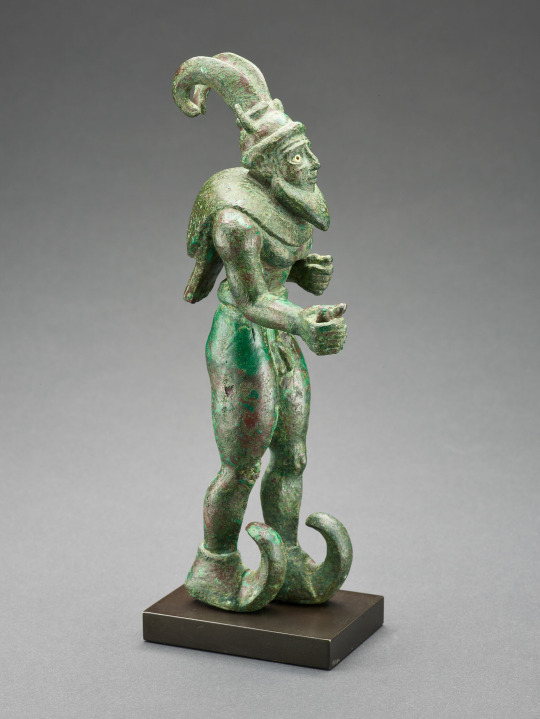
Statuette of a Striding Figure
Mesopotamian, 3000-2800 BCE
Cast in solid copper and executed with a remarkable degree of sophistication, this statuette is thought to represent a supernatural being that served as an intermediary between the physical world and the spiritual realm.
190 notes
·
View notes
Note
Do you have a favorite of your own characters? Or certain ones that you feel particularly connected to? I feel like creators tend to put bits of themselves into their characters--are any of them like that for you? Just wanna say your work is a huge inspiration to me and really helped shape my art and taste in media growing up, thanks for putting your work out into the world!!!
Theoretically, I love them all.
They're all a part of me in some way.
I've discovered over the years that I just can't handle characters I can't relate to. Most specifically, Billy, Mandy, and Grim are major facets of my personality. I purposefully related them to Freud's Id, Ego, and Superego, but they're all very specifically also a part of who I am. Billy is my fun-loving lust for freedom from schedules and consequences. Mandy is the part of me that realizes that Billy will destroy us all, so there must be structure. Grim is just trying to live his life. He wants to watch TV and pet cats, but life (unlife?) just won't give him a break. He's the viewpoint character to my Asperger's.
Irwin is the sad-sack/misguided hero redeemed, which is always a trope I love.
Eris is specifically the Discordian Eris, but also the extreme end of that Billy lust for freedom and the will of the RNG gods. (Good gravy -- my current BG3 playthrough)
Nergal is my love for Lovecraftian/Howardian Mesopotamian deities as has-beens.
Jeff the Spider (quite literally me at the time of his inception) was Too Nice, and therefore a sucker.
Hoss Delgado is the knowledge that if you gaze too long into the abyss... you end up with a chainsaw for a leg.
Then (because this is a collaboration) you've got characters who are primarily created by and representative of other people. For example, Fred Fredburger was created by C.H. Greenblatt. Sperg was created by Gord Zajac (as was Hoss, really). Boogey was created by Spencer Laudiero. All of these artists infused some piece of themselves into the character.
This is (IMO) where it gets fun. It's the ultimate Role Playing Game. It's childhood play made manifest. I've got my Luke Skywalker figure and you've got your Darth Vader figure and we've got two COBRA H.I.S.S. tanks and a Muffy from Battlestar Galactica and we're gonna hash this shit out.
Ideally, I think I'd want a "Simpsons World". A world where there are zero (or as close as possible) extraneous characters. Everyone represents something and everyone matters. I was so close with B&M. Fingers crossed I get there one day.
294 notes
·
View notes
Text
The transgender and nonbinary people of ancient Sumeria
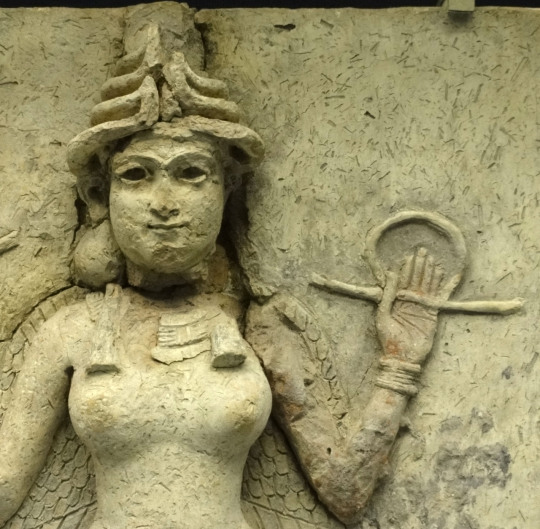
Did transgender people exist before tumblr? Transphobes seems to think transgender identities did not exist before “gender ideology”. Dr. Moudhy Al-Rashid documents the existence of ancient trans people in a thread over at twitter.
//“To turn a man into a woman and a woman into a man are yours, Inana,” reads a 4,000-year-old temple hymn to Inana, the Sumerian goddess of love and war. Non-binary gender identities are not new. Brief thread in response to that one Karen.
Link to A hymn to Inana (Inana C): translation.

Ishtar, the later Mesopotamian goddess of love and war, had gender fluid characterstics. Ashurbanipal’s hymn to Ishtar of Nineveh compares her to the god Ashur. “Like Ashur she wears a beard and is clothed with brilliance...The crown on her head gleams like the stars”

Gender fluid identity appears throughout Mesopotamian history, like that of the assinnu, a word sometimes written as a combination of the cuneiform signs for “man” and “woman”. They served as cultic personnel to Ishtar and even as prophets, like one named Šēlebum in Mari.

In Mesopotamian literature and myth, a gender fluid figure known as an assinnu named Asushunamir, helps rescue the goddess Ishtar when she becomes trapped in the Underworld.
In a Sumerian creation myth, the goddess Ninmah fashions several people out of clay. “She fashioned one with neither penis nor vagina on its body. Enki looked at the one with neither penis nor vagina on its body...and decreed its fate to stand before the king”.
Various other terms appear in cuneiform texts from ancient Mesopotamia that refer to people with non-binary gender and sex. The kalû was a singer, typically a man who participated in activities reserved for women. The pilpilû is one whose sex is “changed” by the goddess Ishtar.

In conclusion, non-binary gender identity is not new and not difficult to understand. Shame on anyone with a platform who uses it to spread misinformation and hate.//
Full thread here.
By the way, one of the clearest proofs of transgender identities in ancient Sumer and Mesopotamia, were the priestesses of Inana (or Inanna, also known as Ishtar). They are known as the Gala (referred to as kalû above). T
hey presided over religious rites, healed the sick, predicted the future, made music, raised money for the poor, and “dissolved evil” during lunar eclipses. They used feminine pronouns and dressed and lived as women. According to several sources they also castrated themselves.
The goddess of Cybele, who is closely related to Ishtar/Inanna, also had transgender priestesses called Galli. That religion became very popular in the later Roman Empire.
Top photo: Ishtar
649 notes
·
View notes